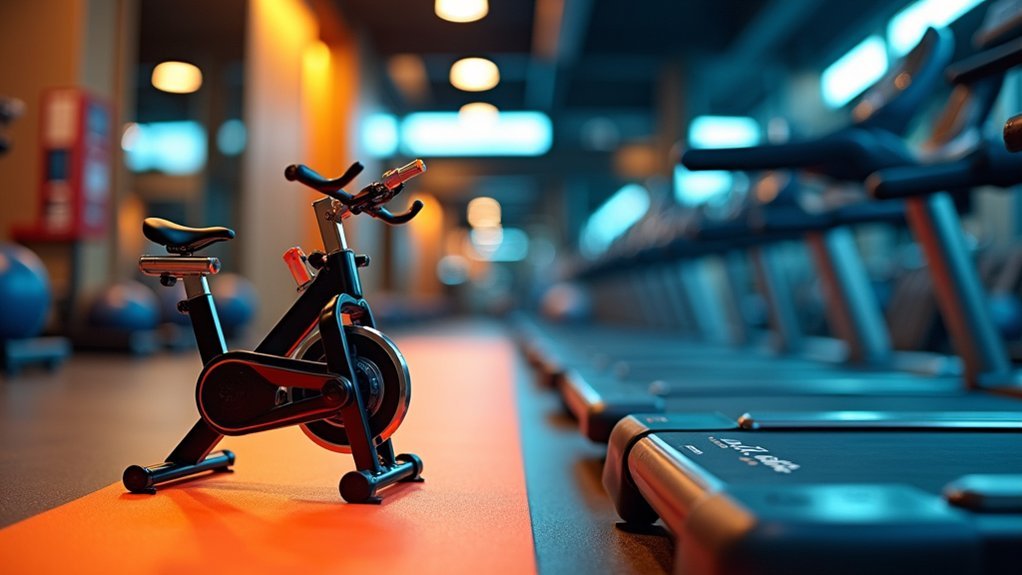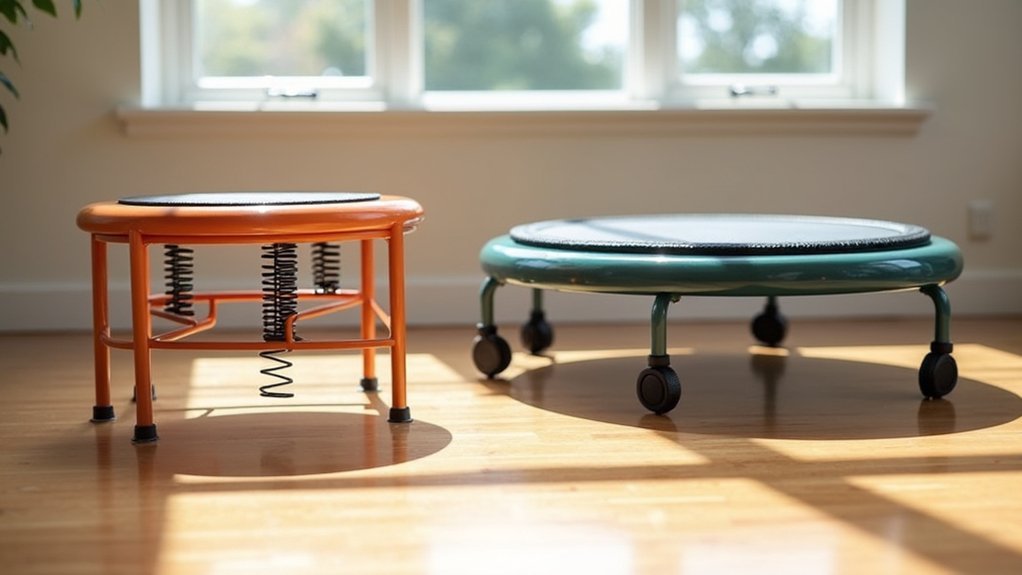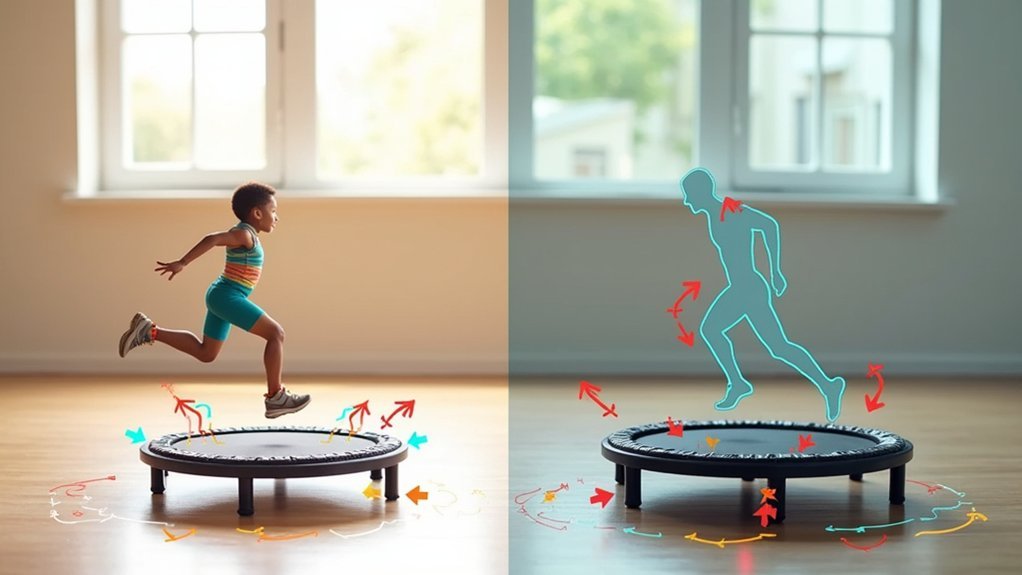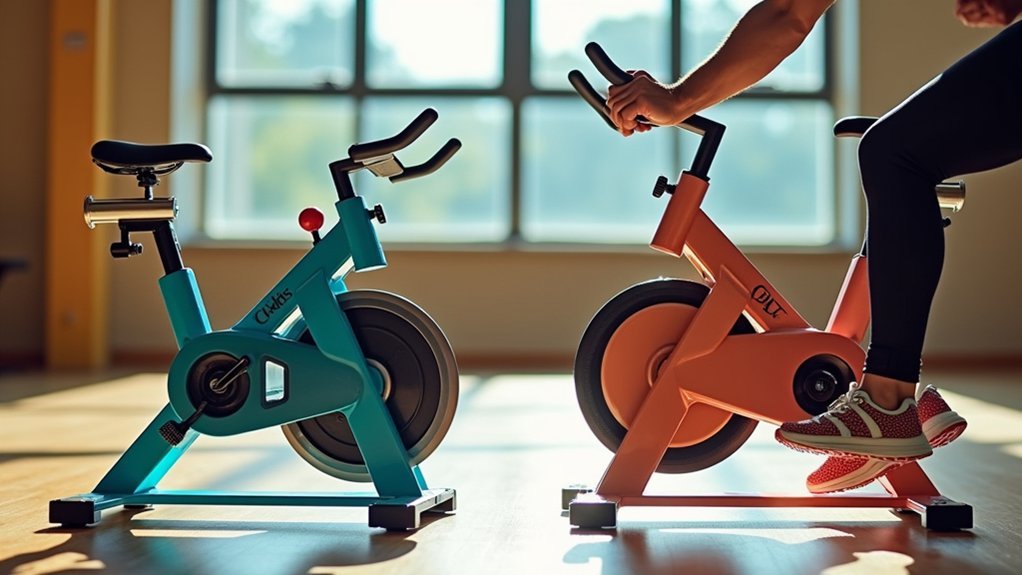Mini exercise machines offer space-saving convenience and portability with lower costs, but you’ll sacrifice stability and resistance compared to full-size equipment. Full-size machines provide better stability, advanced features, and superior energy return, engaging more muscle groups simultaneously. Your choice should depend on your living space, budget, and fitness goals. Mini options work well for casual users with limited space, while serious exercisers benefit from the enhanced capabilities and durability of full-size alternatives. The differences extend far beyond just dimensions.
Size Matters: Mini Vs Full-Size Exercise Comparison

While the fitness world constantly evolves with innovative equipment, one fundamental choice remains: mini versus full-size exercise machines. Your living space and workout goals greatly influence this decision.
Full-size equipment offers superior stability, preventing injuries during intense workouts, plus advanced features like thorough monitoring systems and adjustable settings. These machines enhance cardiovascular health through regular, prolonged use. However, these machines demand substantial space and come with higher price tags.
Invest in full-size machines for stability and advanced features, but prepare for space requirements and higher costs.
Mini equipment—including compact bikes, ellipticals, and steppers—shines in apartments and offices where space is limited. These portable options let you exercise while multitasking and typically cost less than their larger counterparts.
The tradeoff? They generally provide less resistance, may wobble during use, and don’t engage as many muscle groups simultaneously.
Your choice ultimately depends on available space, budget, and fitness objectives.
The Science Behind Rebounding: How Size Affects Your Workout
When you step onto a rebounder, whether mini or full-size, your body experiences a unique combination of forces that creates profound physiological effects. The increased G-force activates your lymphatic system, enhancing immune function and detoxification.
Size influences your workout considerably. Full-size rebounders allow more intense movements with greater force generation, potentially maximizing cardiovascular benefits and bone density improvements in the femur neck. Mini-trampolines provide safer exercise options for individuals concerned about injury risks compared to large backyard trampolines.
Meanwhile, mini-trampolines excel in balance training, improving recovery ability by approximately 35% in seniors.
Both options enhance proprioception and range of motion, but their impact varies based on your goals. For anaerobic performance training, mini-trampolines show notable benefits for athletes.
If you’re managing a neurological disorder, rebounding offers superior quality of life improvements compared to traditional treadmill training.
Space-Saving vs. Full Bounce: Analyzing Mini Rebounder Limitations

Mini rebounders offer space-saving convenience but you’ll notice immediately that their bounce quality differs substantially from full-size trampolines due to limited rebound height and surface area.
Your joints will appreciate the superior impact absorption mini models provide through specialized bungee systems, which diffuse landing forces more effectively than the spring systems in larger trampolines.
You’ll need to adapt your technique when jumping on smaller rebounders, as their reduced diameter requires greater balance control and limits side-to-side movement during dynamic exercises. Family-friendly options like the Fit Bounce Pro provide excellent stability with high-quality materials that ensure safe and effective bouncing during your workout sessions.
Bounce Quality Differences
Although space-saving mini rebounders offer convenience and portability, they come with notable limitations in bounce quality compared to their full-size counterparts.
You’ll experience reduced energy return and limited upward propulsion due to the smaller mat surface area, resulting in shorter airborne intervals and decreased cardiovascular intensity.
Your movement options become restricted on mini models, with less space for lateral exercises like jumping jacks and increased trip risks during directional changes.
While premium mini rebounders with high-tension bungee systems can rival entry-level full-size models, they still typically generate 20-30% lower caloric burn rates.
If you’re seeking advanced vertical movements or diverse exercise routines, you’ll find mini rebounders constraining.
However, quality compact models with customizable tensioning can greatly minimize these limitations, making size a secondary factor with adequate surface responsiveness. Models like JumpSport and Bellicon offer superior bounce and tension that compensates for their smaller diameter compared to traditional trampolines.
Impact Absorption Comparison
Impact absorption, perhaps the most critical feature of any rebounding equipment, differs markedly between mini and full-size rebounders.
When you jump on a mini rebounder, you’ll notice a firmer rebound with shorter deceleration phases, concentrating forces into a reduced surface area. Full-size units distribute these forces more evenly. Fitness trampolines provide more space for high-impact workouts that require greater rebound capacity.
- Your joints experience more stress on mini models as the compact surface provides less gradual deceleration.
- Your stability muscles work overtime on smaller rebounders, potentially limiting workout duration.
- Your lymphatic circulation benefits remain regardless of size, though intensity varies.
- Your risk of falls increases on mini models due to limited perimeter clearance.
This absorption disparity becomes especially relevant for therapeutic applications, where the gentler deceleration of full-size units often proves superior for rehabilitation protocols.
Stability While Jumping
When jumping on a rebounder, stability becomes an essential factor that considerably differs between mini and full-size models. Mini rebounders, with their foldable designs, may sacrifice some stability for portability and space efficiency.
Spring rebounders offer faster, more intense bounces requiring greater balance control, while bungee systems provide more controlled movement. If you’re heavier or need additional support, look for models with adjustable tension to customize your bouncing experience. Individuals of varying weights will experience significantly different bounces since body composition directly affects how the rebounder responds.
For enhanced stability, consider rebounders equipped with handlebars—these accessories considerably improve balance while allowing you to focus on proper form rather than staying upright.
Remember that firmer rebounder tension helps maintain joint stability by reducing excessive motion during your workout, making it particularly beneficial if you have any mobility concerns.
Impact Force Comparison: Body Weight Distribution on Different Sized Rebounders

Your body weight dramatically affects joint load when exercising on different-sized rebounders, with mini models distributing impact forces across a smaller surface area compared to full-sized trampolines.
The impact absorption capabilities vary greatly, as full-sized trampolines with their larger frames and more springs can dissipate forces more effectively than compact rebounders. This is especially true for rectangular trampolines which offer uniform bounce distribution across the entire mat surface.
You’ll experience different recoil energy transfer depending on your weight and the rebounder size, which directly influences both workout intensity and potential joint stress.
Joint Load Analysis
Understanding how your body weight distributes across different sized rebounders is essential for joint health during exercise. Your body experiences different levels of stress depending on the rebounder size you choose.
Mini rebounders typically reduce joint impact due to shorter bounce heights, while full-size models can increase pressure during landings unless they offer adjustable tension.
- Your knees absorb less shock on a mini rebounder as your feet stay closer to the surface
- Your ankles experience more stability on rebounders with bungee cords versus metal springs
- Your spine compresses less when you use proper landing techniques on either size
- Your joints benefit from handlebars for support during complex movements
Remember that your body composition considerably affects joint load—a 300-pound person experiences twice the pressure of someone weighing 150 pounds on identical equipment.
High-quality rebounders like the Cellerciser® are specifically designed to provide low-impact cardio exercise while minimizing strain on your joints compared to traditional ground-based activities.
Impact Absorption Differences
Impact force distribution varies dramatically between mini and full-size rebounders, directly affecting how your body absorbs shock during exercise.
On mini trampolines, your weight concentrates over a smaller area, creating higher force per unit area but with lower reaction forces—making them ideal for rehabilitation and balance training. According to real-world measurements, mini-trampolines can generate up to 6.9G of force on the body during typical use.
Full-size trampolines spread your weight across a larger surface, reducing localized pressure but potentially increasing overall impact due to higher jumps. You’ll experience faster rebounds and greater stored energy from the expanded surface area.
The safety implications differ too: younger children face higher injury risks on mini trampolines, often from improper landings, while older users typically experience more lower extremity strains on full-size models.
Your choice should reflect your fitness goals, age, and physical condition.
Recoil Energy Transfer
Recoil energy transfer between you and a trampoline dramatically shifts depending on whether you’re using a mini or full-size rebounder.
Full-size trampolines provide greater energy conversion efficiency due to more springs and larger surface area, resulting in higher bounces and longer air time.
Your body weight plays a significant role in both scenarios.
On mini rebounders, you’ll experience:
- Faster recoil response due to stiffer springs
- More controlled, lower-height bounces ideal for fitness routines
- Greater energy loss with heavier users
- Consistent rebound regardless of jumping position
On full-size trampolines, your weight creates deeper depression in the mat, storing more potential energy before converting it to kinetic energy during recoil. This process follows Hooke’s Law where the force needed to stretch the trampoline is proportional to the distance it stretches.
This makes full-size options superior for recreational use where height and air time are desired.
Stability and Safety: Navigating Rebounder Size Considerations
When choosing between mini and full-size rebounders, stability and safety considerations should guide your decision as much as space constraints. Full-size models with larger jumping surfaces provide better landing control, while adjustable tension accommodates different body weights. The quality of your rebounder directly affects your exercise effectiveness, as poor rebounders can lead to injury and compromise your workout results.
| Feature | Mini Rebounders | Full-Size Rebounders |
|---|---|---|
| Surface Area | Limited (39″-44″) | Spacious (up to 1.12m) |
| Weight Capacity | Often lower | Generally higher |
| Stability | Less stable for lateral movements | Better for complex exercises |
| Fall Risk | Higher trip potential | Lower with proper space |
| User Suitability | Ideal for petite users (<5'4") | Better for tall users (>6′) |
Your demographics matter too—seniors benefit from handlebar-equipped full-size models, while athletes need adequate stance width for plyometric training. Remember that structural design elements like wider bases and weight-rated components considerably impact safety during high-intensity workouts.
Calorie Burn Analysis: Does Rebounder Size Affect Weight Loss Results?
How much does rebounder size truly affect your weight loss journey? The evidence suggests that size is less influential than how you use your rebounder.
While larger models offer more movement space, calorie burn primarily depends on intensity, duration, and consistency—not surface area.
The real weight loss drivers include:
Weight loss on a rebounder depends on intensity, variety, intervals, and consistency—not just bounce surface size.
- Your bouncing intensity—higher jumps and faster movements can burn up to 876 calories per session
- Workout variety—incorporating high knees, jogging, and arm movements increases muscle engagement
- Interval training—alternating between high and low-intensity rebounding maximizes calorie expenditure
- Session frequency—consistent 8-10 minute daily sessions can be more effective than occasional lengthy workouts
Studies show different individuals will experience varying results, with heavier people burning more calories during identical rebounding sessions due to greater energy expenditure.
Choose a rebounder that encourages regular use rather than focusing solely on size for ideal weight loss results.
Bounce Quality: How Surface Area Influences Exercise Effectiveness
You’ll notice significant differences in how mini and full-size trampolines distribute your body weight across their surface during exercise.
Your balance is challenged differently on a larger trampoline where movements create wider energy dispersal patterns compared to the concentrated feedback from a mini rebounder.
The energy return also varies between sizes, with full-size trampolines typically offering more powerful rebound potential that can intensify your workout while potentially reducing joint stress through better force distribution. NASA research confirms that rebounding’s unique gravitational stimulus strengthens muscles and bones without stressing specific joints compared to traditional exercise forms.
Impact Surface Dynamics
The difference between mini and full-size exercise equipment becomes immediately apparent when examining bounce quality and impact absorption. When you exercise on full-size equipment, your body experiences more evenly distributed forces across larger contact areas, considerably reducing injury risk. Research shows that surface type is the most important feature for older adults when designing outdoor fitness areas.
- Your joints absorb shock more efficiently on properly padded full-size surfaces.
- Your movements flow naturally without the constraints of limited surface dimensions.
- Your form remains proper when equipment matches your body’s biomechanical needs.
- Your exercise intensity can scale safely without compromising alignment.
Mini equipment’s smaller contact points concentrate stress in ways that alter natural movement patterns. Without adequate surface area matching your exercise kinematics, you’ll notice compromised bounce quality and potentially develop compensatory movements that reduce effectiveness and increase injury potential.
Balance During Motion
Surface area fundamentally impacts your ability to maintain balance during dynamic movements, creating a critical trade-off between stability and muscle activation.
When you exercise on smaller platforms like mini-trampolines or BOSU balls, you’ll activate your core muscles up to 156% more than on stable surfaces, but sacrifice about 29% of your force output.
This trade-off becomes particularly evident during exercises requiring continuous adjustment. Your body prioritizes recruiting slow-twitch muscle fibers for stability rather than fast-twitch fibers needed for explosive movements.
That’s why jumping height improves only 4.6% with sensorimotor training versus traditional methods.
For athletes seeking performance gains, stable surfaces remain superior for developing power.
However, if you’re rehabilitating from injury, smaller surface areas offer valuable proprioceptive training that stable platforms can’t match. Exercise interventions have shown significant improvements in muscle strength for individuals recovering from burns, highlighting the importance of surface selection in rehabilitation protocols.
Energy Return Differences
Beyond balance advantages, exercise equipment’s bounce quality transforms workout effectiveness through its energy return properties.
Full-size equipment greatly outperforms mini versions by providing superior energy recycling during your workouts.
The physics behind this difference is substantial:
- Your body weight creates deeper deformation on larger surfaces, storing more potential energy that returns to assist your movements.
- Full-size equipment’s multi-layered construction creates a stiffness gradient that optimizes the timing of energy return during your 0.2-second contact phase.
- Mini surfaces concentrate impact forces in smaller areas, quickly reaching their energy storage limits during repetitive loading.
- Structured surfaces on full-size equipment can deliver up to 10x higher energy return through optimized directional rebound patterns.
Similar to how treadmills provide a controlled environment with lower plantar forces and reduced injury risk compared to hard surfaces, full-size exercise equipment offers controlled impact absorption.
Durability Face-Off: Lifespan of Mini Vs Full-Size Rebounders
When considering a fitness investment, understanding the durability differences between mini and full-size rebounders becomes essential for long-term satisfaction.
Full-size trampolines outperform mini rebounders with lifespans of 5-15 years versus 3-7 years for indoor minis.
You’ll notice significant warranty disparities, with full-size models offering 5-10+ year coverage while mini versions typically provide just 1-5 years.
Full-size trampolines utilize galvanized steel frames and UV-resistant mats that withstand outdoor conditions, whereas minis require frequent tension checks and yearly mat replacements with heavy use.
The difference between rebounders and full-size trampolines becomes particularly apparent in their installation and maintenance needs, with rebounders requiring minimal upkeep compared to their larger counterparts.
Your mini rebounder will develop edge stitching tears faster due to concentrated bouncing, while full-size models distribute weight more evenly across 6-8 legs.
Consider these durability factors alongside the initial investment: $50-$500 for minis versus $300-$2,000+ for full-size options.
Versatility in Training: Exercise Possibilities Based on Rebounder Dimensions
The versatility of your rebounder greatly impacts your workout options, with size dimensions playing a critical role in exercise possibilities.
Mini rebounders (35-48 inches) excel in small spaces, offering controlled movements perfect for low-impact cardio and core strengthening. Meanwhile, full-size trampolines provide expanded range for dynamic exercises and higher bounces.
Your exercise space matters: mini rebounders deliver precision in tight areas while full-size trampolines unleash dynamic aerial potential.
Your workout experience varies dramatically between these options:
- Mini rebounders: Visualize performing precise jumping jacks and controlled jogging in place while maintaining perfect balance on a compact surface.
- Bungee-cord models: Picture yourself experiencing gentle landings as the flexible cords absorb impact.
- Full-size trampolines: Imagine executing twists and somersaults with ample space for aerial movements.
- Multi-user sessions: Envision enjoying social workouts with friends or family on larger rebounders.
Regardless of size, rebounding workouts provide excellent cardiovascular benefits that can burn calories comparable to running at a 10-minute mile pace while being gentler on your joints.
Joint Impact Assessment: Finding the Right Size for Low-Impact Benefits
Selecting the appropriate rebounder size directly influences joint health, making this choice essential for anyone seeking low-impact exercise benefits.
Full-size ellipticals engage multiple muscle groups simultaneously, distributing workout intensity and potentially reducing overuse injuries through balanced exercise.
Mini equipment offers comparable joint protection benefits in a more compact form. These portable options focus primarily on lower body conditioning while maintaining the low-impact circular motion that minimizes stress on knees, ankles, and hips.
You’ll find underdesk ellipticals and mini pedal bikes particularly useful if you’re concerned about joint health but have limited space. Many users who value compact design might also appreciate the wall-mounted design of options like the Tonal 2 Smart Home Gym.
Both options considerably reduce joint pressure compared to high-impact activities like running, though your specific needs regarding space, budget, and workout versatility should guide your final decision.
Portable Rebounding: When Smaller Size Creates Exercise Consistency
Portable rebounder designs revolutionize exercise adherence through their space-efficient profiles and ready accessibility. You’ll find these compact fitness tools slide easily under beds or sofas, eliminating the “out of sight, out of mind” phenomenon that derails many workout routines.
Their sub-60-second setup transforms brief windows of opportunity into effective exercise moments.
- Imagine squeezing in a quick bounce session during commercial breaks while never missing show content
- Picture moving your rebounder from living room to balcony on sunny days without breaking a sweat
- Visualize maintaining your fitness routine in hotel rooms during business travel
- Envision creating a spontaneous family activity when children need energy release
These mini rebounders offer the same lymphatic health benefits as their larger counterparts while requiring significantly less space. This accessibility transforms exercise from scheduled obligation to convenient lifestyle integration, making consistency nearly automatic.
Investment Value: Cost-Benefit Analysis of Different Sized Rebounders
While portable rebounder accessibility makes exercise consistency attainable, understanding the financial implications helps you make a sound purchasing decision. Your investment should align with your usage patterns and fitness goals. Full-size rebounders (44-inch models) provide more workout area for complex movements and are particularly beneficial for taller individuals.
| Factor | Mini Rebounders | Full-Size Rebounders |
|---|---|---|
| Initial Cost | $100-$200 | $300+ |
| Longevity | Moderate | Extended |
| Space Required | Minimal | Substantial |
| Workout Variety | Limited | Extensive |
| Family Usage | Individual | Multiple users |
Though mini trampolines cost less upfront, full-size models offer better long-term value for frequent exercisers. Consider how often you’ll use your rebounder—daily workouts justify spending more on a durable, larger model with diverse exercise options. For families, larger rebounders distribute the cost across multiple users, potentially making their higher price tag more economical per person.
Frequently Asked Questions
Can Children Safely Use Mini or Full-Size Exercise Machines?
Children can use mini exercise machines with supervision, but they’re not safe on full-size equipment. You should always supervise usage, guarantee proper sizing, and unplug machines after use to prevent accidents.
How Do Noise Levels Compare Between Mini and Standard Equipment?
You’ll notice mini equipment generates considerably less noise than standard equipment. Your mini machines have fewer moving parts and lighter weights, while standard equipment can reach 110-115 dB when weights are dropped.
Are Mini Machines Effective for Physical Rehabilitation Purposes?
Yes, mini machines are effective for your physical rehabilitation. They improve outcomes, target specific muscle groups, and offer accessibility advantages. You’ll benefit from their portability, cost-effectiveness, and integration with technology during recovery.
Can Overweight Individuals Use Compact Exercise Equipment Safely?
You’ll need to exercise caution with compact equipment if you’re overweight. It often lacks sufficient weight capacity and stability. For safety, look for full-size options with higher weight limits and sturdy construction.
Do Mini Machines Require More Frequent Replacement Than Full-Size Versions?
Yes, you’ll likely replace mini machines more often than full-size versions due to their lighter materials, smaller components that wear faster, and difficulty of repairs when parts break down.
In Summary
When choosing a rebounder, you’ll need to balance your space constraints with workout goals. Mini rebounders offer convenience and portability but limit exercise variety and impact distribution. Full-size options provide better stability, bounce quality, and versatility for advanced movements. Consider your joint health, available space, and long-term fitness plans. Ultimately, the right size depends on your personal priorities—convenience, workout intensity, or exercise variety.





Leave a Reply